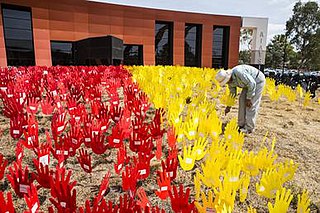Related Research Articles

The Australian Aboriginal languages consist of around 290–363 languages belonging to an estimated 28 language families and isolates, spoken by Aboriginal Australians of mainland Australia and a few nearby islands. The relationships between these languages are not clear at present. Despite this uncertainty, the Indigenous Australian languages are collectively covered by the technical term "Australian languages", or the "Australian family".

The Australian Institute of Aboriginal and Torres Strait Islander Studies (AIATSIS), established as the Australian Institute of Aboriginal Studies (AIAS) in 1964, is an independent Australian Government statutory authority. It is a collecting, publishing and research institute and is considered to be Australia's premier resource for information about the cultures and societies of Aboriginal and Torres Strait Islander peoples. The Institute is a leader in ethical research and the handling of culturally sensitive material and holds in its collections many unique and irreplaceable items of cultural, historical and spiritual significance. The collection at AIATSIS has been built through over 50 years of research and engagement with Aboriginal and Torres Strait Islander communities and is now a source of language and culture revitalisation, native title research and family and community history. AIATSIS is located on Acton Peninsula in Canberra, Australian Capital Territory.
Nhanda, also rendered Nhanta and Nhandi, is an Australian Aboriginal language from the Midwest region of Western Australia, between Geraldton and the Murchison River, from the coast to about 20 kilometres (12 mi) inland. The language is now spoken, or semi-spoken, by only a few people.
The Yinggarda language is an Australian Aboriginal language. It is an endangered language, but efforts at language revival are being made.
Bininj Gun-Wok is an Australian Aboriginal language group which includes six dialects: Kunwinjku, Kuninjku, Kundjeyhmi, Manyallaluk Mayali (Mayali), Kundedjnjenghmi, and two varieties of Kune. Kunwinjku is the dominant dialect, and also sometimes used to refer to the group.
Diyari or Dieri is an Australian Aboriginal language spoken by the Diyari people in the far north of South Australia, to the east of Lake Eyre. It was studied by German Lutheran missionaries who translated Christian works into the language in the late 19th and early 20th centuries, so that it developed an extensive written form. Only a few fluent speakers of Diyari remained by the early 21st century, but a dictionary and grammar of the language was produced by linguist Peter K. Austin, and there is a project under way to teach it in schools.
Indigenous Australians are people with familial heritage to groups that lived in Australia before British colonisation. They include the Aboriginal and Torres Strait Islander peoples of Australia. The term Aboriginal and Torres Strait Islander people, or the person's specific cultural group, is often preferred, though the terms First Nations of Australia, First Peoples of Australia and First Australians are also increasingly common.
Lower Arrernte, also known as Lower Southern Arrernte, Lower Aranda, Lower Southern Aranda and Alenjerntarrpe, was an Arandic language. Lower Arrernte was spoken in the Finke River area, near the Overland Telegraph Line station at Charlotte Waters, just north of the border between South Australia and the Northern Territory, and in the Dalhousie area in S.A. It had been extinct since the last speaker died in 2011, but there is now a language revival project under way.

The Yuin–Kuric languages are a family of mainly extinct Australian Aboriginal languages that existed in the south east of Australia.
Marrithiyel, also known as Berringen, is an Australian Aboriginal language spoken by the Marrithiyal people.
The Maringarr language is a moribund Australian Aboriginal language spoken along the northwest coast of the Northern Territory.
Taribelang, also known as Gureng Gureng, is a language of Queensland. Although no longer spoken as a native language by the Goreng goreng or Goeng people, it is spoken as a 2nd or 3rd language by under 100. There exists some confusion between Austlang's (AIATSIS) E33: Taribelang and E36: Goeng Goeng languages.

Bayali was an extinct language of Queensland in Australia, spoken in the Rockhampton area, but a project is under way to revive the language.
The Ritharnggu language is an Australian Aboriginal language of the Yolŋu language group, spoken in Australia's Northern Territory.
The Wemba Wemba language is an extinct Aboriginal Australian language once spoken along the tributaries of the Murrumbidgee River.
The Nhanhagardi language, also written Nana karti, Nanakarti, Nanakarri, Nanakari, and Nanakati, and also known as Wilunyu, Wiri, Minangu, Barimaia and Jaburu, is an Aboriginal Australian language of the Champion Bay area of Western Australia.
The Yiman language is an Australian Aboriginal language of Queensland. Ethnically the speakers were Bidjara; that and geography suggests that it may have been a Maric language, assuming it was a distinct language at all. It is attested in a word list collected by Meston and held in the State Library of Queensland, but as of 2014 the data had not been verified by the Australian Institute of Aboriginal and Torres Strait Islander Studies.
The Tulua people were an Aboriginal Australian people of Queensland, in the southern to central region from the coast to the ranges. The Dappil and Tulua people possibly spoke the same language.
The Goeng or Goeng Goeng were an Aboriginal Australian people of the state of Queensland. They lived in the area of the area of present-day Gladstone.
References
- 1 2 "E41: Tulua". Austlang. AIATSIS. Retrieved 14 January 2020.
- ↑ E41 Tulua at the Australian Indigenous Languages Database, Australian Institute of Aboriginal and Torres Strait Islander Studies
- ↑ "Priority Languages Support Project". First Languages Australia. Retrieved 13 January 2020.
| This Australian Aboriginal languages-related article is a stub. You can help Wikipedia by expanding it. |